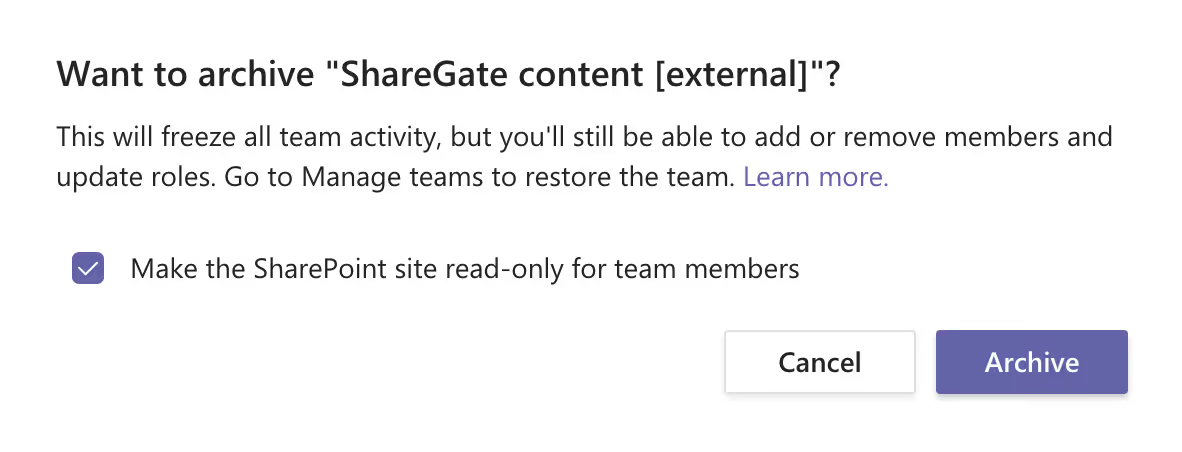How to archive teams: manage or delete chat, channels, and content in Microsoft Teams

Table of contents
Whether you're concerned with compliance or cleaning up inactive teams, here's how to archive a team—along with its conversations, channels, and content—in Microsoft Teams.
While Teams is surprisingly easy to use, it's also easy to use improperly. Users who don't know about all the different ways to create a new Microsoft 365 Group or team can wind up creating duplicates accidentally. And having tons of unnecessary or inactive teams lying around can lead to your tenant sprawling out of control faster than you'd think.
👉Free online course: How to get sprawl under control now and in the future.
So what can you do to keep things organized and up-to-date? Depending on your organization's specific concerns, you have three options to choose from for managing your Microsoft teams. Let's take a look!
Option 1: Apply Teams retention policies
If compliance is a big concern for your organization, retention policies are probably your best bet.
They're designed to address a specific compliance requirement by preserving or deleting data after the expiration timeline that you've set. Retention can be applied while a team is still active—so its main goal isn't really about keeping things clean.
Because each team has associated workloads spanning multiple Microsoft 365 products, a team's content is stored in more than one place. Depending on the type of content you want to retain, you can apply retention...
Organization-wide: Applied across your entire tenant, including the following products:
- Exchange email (Exchange Online Plan 2 license needed)
- SharePoint sites
- OneDrive accounts
- Microsoft 365 Groups (applies to content in the group's mailbox, site, and documents)
- Exchange public folders
To specific Microsoft 365 products: With the possibility of including or excluding specific groups, sites, user mailboxes, and OneDrive accounts. It's important to note that Microsoft Teams has its own unique retention policy, and so they aren't included in retention policies applied to Microsoft 365 Groups.
There are two types of Teams-specific retention policies that admins can set in the Security & Compliance area of the Microsoft Teams admin center:
- Preservation: Sometimes, for compliance reasons, you want to make sure data is preserved for eDiscovery requirements, no matter what happens in the end user tools. These policies preserve your data for a designated period of time, after which the policy can indicate whether to do nothing or delete the data.
- Deletion: On the other hand, you might want to delete data so its not a liability. Like preservation policies, you choose an expiration timeline—after which the data is deleted.
It's worth noting that these Teams retention policies only apply to Teams chat and channel messages, and can only be applied tenant-wide—not to specific teams. You can find more details about Teams retention in the official Microsoft documentation.
At the end of the day, retention policies are designed for compliance. You can only set policies based on a timeline—which might not be correlated to actual usage. And because retention can be applied while a team is still active, retention on its own won't necessarily manage Teams data the way you want.
Option 2: Archive teams directly in the Microsoft Teams admin center
Microsoft also gives you the option to archive a team, putting it in a read-only state. You'll still be able to search through an archived team for stuff that you need, and you can choose to reactivate it (or delete it) at some point in the future.
Only the team owner and admins with access to the Teams admin center can archive and restore teams, and the chats and files in the team become read-only once archived.
To archive a team
- Select Teams in the left sidebar to see the list of all your teams.
- Select Manage (the gear icon) at the bottom of the list.
- Find the team you want to archive, select More options, then Archive team.
- Select Make the SharePoint site read-only for team members to prevent people from editing the content in the associated SharePoint site and Wiki tab (although team owners can still edit this content).

How to unarchive a team
Follow the same steps 1 and 2 above. Then, find the name of the team you want to restore in the Archived list of teams, select More options, then Restore team.
What happens when you archive a team?
For detailed step-by-step instructions on archiving, restoring, and searching through archived team content, check out the official Microsoft support documentation.
The biggest downside to this method? What Microsoft refers to as "archiving" isn't really archiving in the true sense of the word—i.e. transferring data somewhere else. An archived team's chats and files will still be visible and appear in search; team members just can't modify them. If the end goal is to declutter and make Teams easier to navigate, this won't exactly work.
You can delete an entire team if you want actually to remove all of its content. But be very careful: while you can restore a deleted team by restoring its associated Microsoft 365 Group, deleted Microsoft 365 Groups are only retained for 30 days (a period referred to as "soft-delete"). Once that timeframe has passed, there's no way to get a deleted group or team back.
Option 3: Find and manage teams you no longer need
But what if your main goal isn't compliance? What if you just want to make Teams easier to navigate and search through?
If you want to improve usability, you need to identify unnecessary teams that aren't being actively used, then remove those teams from your tenant—either by deleting them or storing them somewhere else.
For now, finding potentially obsolete teams requires that you either:
- Run a Teams usage report. The Microsoft Teams usage report in the Teams admin center shows things like the number of active users and channels, as well as usage information for individual teams—including the number of active users and channels, guests, and messages. But you can only view a report for the last 7 or 28 days. Such a short timeline won't necessarily give an accurate picture of whether a team is still needed or in use.
- Script with PowerShell. If you're comfortable using PowerShell, this script posted to Microsoft's TechNet portal can help identify potential candidates for removal by generating an activity report. A group or team is deemed "inactive" when there's been no recorded use of the associated mailbox, SharePoint site, or chats in awhile.
- Use a third-party tool. A third-party tool like ShareGate can monitor your tenant for you, and automatically detect inactive teams based on user activity and the policies that you've set.
The first two options leave a lot of the onus on IT—from scripting to running and interpreting a report—making it harder for Teams to scale as fast as your organization. And then there's still the problem of what to do with those teams. Delete them? Leave them where they are in a read-only state?
We wrote this article on how to find inactive Microsoft Teams in 4 different ways, to explain the subject further.
ShareGate can help identify inactive teams, AND archive their files and folders for you (in the true sense of the word!). When you archive a team, we copy its content and store it securely—on our Azure server or yours. So you can delete the team from your tenant and only keep resources that are actually being used.
FAQ: Archive Teams in Microsoft Teams
TLDR? We've got your answers
What is team archiving in Microsoft Teams? Archiving a team is a way to preserve or delete data associated with a team after an expiration timeline. This is useful for compliance or cleaning up inactive teams.
How do I archive a team in Microsoft Teams? To archive a team, navigate to the Teams section in the left sidebar and select manage (it looks like a gear). Find the team you want to archive, select the three dots, and click archive team. Note: only team owners and admins with access to the Teams admin center can do this.
What happens to the chats and files in an archived team? When the team is archived, the info within it becomes read-only. You can see it, search it, and view it. But you can't edit.
Can I reactivate an archived Teams team? Of course! You can reactivate a team at any time. To do this, go to the Teams section in the left sidebar, select manage (the gear icon), and navigate to your archived team. Click on the three dots, and select reactivate team.
Can I delete an archived team? Yes. This removes it forever, so do this with caution. To tod this, go to the Teams section in the left sidebar, select manage (the gear icon), and navigate to your archived team. Click on the three dots, and select delete team.
How does archiving differ from retention policies? Well, you see, retention policies are usually to preserve or delete data based on some specific criteria. Archiving teams puts the content in a read-only state. Retention policies also can be added to any specific team or even tenant-wide. Team archiving is a manual process using the Microsoft Teams admin center. Or, to get the job done faster, you can use a third-party tool like ShareGate. We automate the review and archive process for you. Nice, eh?
Can retention policies be applied to specific teams in Microsoft teams? Nope. Retention policies are for the whole tenant.
How do I set retention policies for teams in Microsoft Teams? Navigate to the Security & Compliance area of the Teams admin center. Here, you can easily set policies to preserve data or deletion.
How do I manage inactive teams in Microsoft Teams? Well hey, you can read the article above or - use retention policies, archive teams manually, or delete them. Identify which ones are inactive and take charge!
What should I consider when archiving teams in Microsoft Teams? There's a lot you can look at. Considering compliance and security requirements should be at the top of the list, protecting sensitive data is paramount. Think about how useful this data might be in the future, and who it may impact if you archive the team. Ask team owners for input where possible and make it a collaborative effort. Good luck!
.jpg)


.svg)
.avif)
%20(1).avif)














